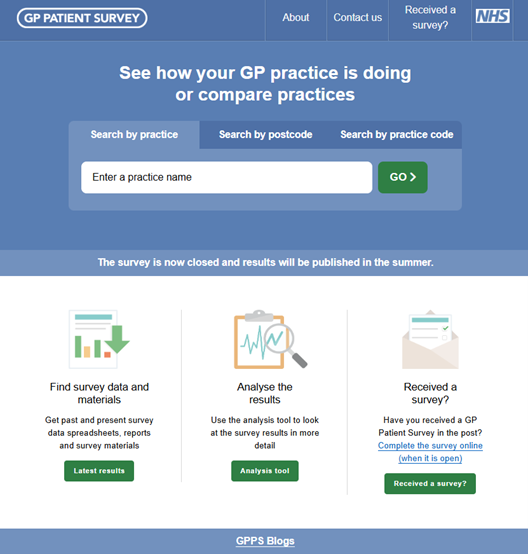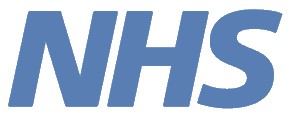Technical annex Download
4 Communications with patients and practices
To raise the profile of GPPS and provide patients and practices with support and information about the survey, a series of communication activities are undertaken, such as hosting a survey website and providing a survey helpline to respond to frequently asked questions. These are described in more detail below.
4.1 Survey website
A dedicated survey website is maintained and hosted by Ipsos. The advertised web address is www.gp-patient.co.uk. This site is designed to reflect the branding of the questionnaire and all other related materials (see Figure 4.1: The www.gp-patient.co.uk homepage).
Figure 4.1: The www.gp-patient.co.uk homepage

The website is updated on the first day of fieldwork, as the first questionnaires are delivered to patients, to indicate that the survey is open. It consists of a number of sections, detailed below:
-
'About' covers the aims of the survey, ways to take part and information about accessibility. This page includes links to information in British Sign Language (BSL) and 14 additional languages which explain the survey, provide responses to a selection of FAQs, and link to online translated versions of the questionnaire.
-
'Received a survey?' provides information about the online version of the survey and links to complete it in either English, BSL or another language. This page also includes links to easy read information sheets (both with and without images), an easy read privacy policy and the accessibility page.
-
'Languages' provides information about GPPS in British Sign Language (BSL) and 14 additional languages, including Arabic, Bengali, Chinese (Simplified), French, Gujarati, Italian, Polish, Portuguese, Punjabi, Romanian, Slovak, Spanish, Turkish and Urdu. The FAQs (including privacy information), questionnaire, and covering letter are all translated into these languages to make the survey as widely accessible as possible.
-
'Promote the survey' provides tips to GP practices for promoting the survey and contains a printable poster in English and 14 other languages.
-
'Frequently Asked Questions (FAQs)' includes information about how patients are selected, help with completing the survey, data protection and accessing the results.
-
'What do you think about the website?' is a link to a form allowing users to rate the site, provide comments and leave contact details.
-
'Search for a practice' takes users to the practice reporting tool, which allows them to view results for a specific practice.
-
'Compare a practice' allows users to compare the results of different practices.
-
'Analysis tool' is a link to the analysis tool which allows users to interrogate the GPPS data further (see section 8.9: Deliverables).
-
'Latest results' takes users to the latest survey datasets, reports, questionnaire, and letters. It also includes an archive of all previous survey results and materials. This can also be accessed via the 'Past surveys' link.
-
'For GP staff' contains information for GPs about the benefits of the survey.
-
'Why use the data' provides information about GPPS, what information can be found in the survey results, and how the website can help the user. It also includes a GP Handbook developed by academic partners giving practices advice on how to use their survey results to improve patient care.
-
'How do I?...' provides guidance on how to complete the survey, how to find practice, PCN and ICS data, and how to use the website and analysis tool to conduct further analysis on the data.
-
'Uses of GPPS' details a number of examples about how GPPS data is used. This includes uses by national organisations and a series of case studies.
-
'Privacy notice' provides information about how the information collected on the GPPS website is used.
-
'Sitemap' lists out all the pages on the website.
-
'Site feedback' contains contact details for users to provide feedback on the website and includes another link to the user feedback form.
-
'Contact us' provides a link to telephone and email contact details for the GPPS team at Ipsos.
-
'Accessibility' gives information on how the website can be adapted or used by people with different accessibility requirements, such as by changing the text size, background colours, keyboard navigation or using with a screen reader.
4.2 Support for participants
4.2.1 Telephone helpline
Ipsos offer a Freephone helpline for patients who have any questions about the survey, with separate numbers for English and 14 additional language lines. In total, 17,166 calls and voicemails were handled by the helpline team over the course of 2025 fieldwork.
4.2.2 English language telephone helpline
The English language helpline was staffed by a fully trained Ipsos team between 8am and 9pm on weekdays and 10am to 5pm on Saturdays 30 December 2024 to 31 March 2025. Depending on the volume of calls, a voicemail system may be used during quieter periods (see details below). For call handlers to answer patients’ queries, they are provided with a manual containing a complete list of over 300 FAQs. These are updated annually to address any new or emerging queries patients may have. Where the call handlers cannot answer a query, the details are passed on to the GPPS research team who will respond directly.
During quieter periods (generally 10 days after each mailing) the helpline may switch to a voicemail message which briefly explains the purpose of the survey and asks the caller to leave a message and telephone number if they wish to be called back. Call handlers then return the calls within two working days, making up to eight attempts to reach the caller.
As well as being a source of information for patients, the helpline also enables sampled patients to complete the survey over the telephone.
In addition, patients can opt out of the survey by providing their access code or contact details to the helpline.
4.2.3 Additional language telephone helpline
To make the survey as accessible as possible, there are separate helplines for each of the 14 additional languages that the survey is offered in. Each language has its own Freephone number which is connected to a voicemail message in the corresponding language. As with the English language voicemail, a message briefly explains the purpose of the survey and asks the caller to leave a message and telephone number if they wish to be called back. Ipsos will arrange for Language Line to return the calls within two working days. Again, up to eight attempts are made to return the call. As with the English language helpline, patients are able to complete the survey over the phone or opt out of taking part.
4.2.4 Email helpline
As well as using the telephone helpline, patients are also able to email the GPPS team at Ipsos with any queries. In total, 3,263 email queries were received and responded to during fieldwork in 2025.
4.2.5 Written correspondence
The survey also generates a large volume of mail returned to the Freepost address, including letters and notes addressed to the survey team or to NHS England. This is separated from the returned questionnaires and delivered to the helpline team on a weekly basis for review. Where a response is requested or deemed otherwise necessary, a written response will be sent to the patient. For 2025 fieldwork 889 letter responses were sent.
4.2.6 Safeguarding
Most calls and other correspondence received about the survey are relatively straightforward, and the helpline team are well briefed and experienced in engaging with respondents ethically and sensitively. However, where a cause for safeguarding concern occurs a formal protocol (agreed with NHS England) outlines the procedures that staff should follow. All potential safeguarding cases are reviewed by the research team, and if necessary, escalated to the Ipsos GPPS Ethics Board, a group with particular experience in safeguarding situations. If advised by the Ethics Board, the circumstances are then shared with NHS England. This process ensures all instances are dealt with as sensitively and quickly as possible. For 2025 fieldwork, the Ethics Board reviewed and agreed a course of action for two potential safeguarding queries.
4.2.7 Data protection protocols
We have several formal protocols in place to respond to data protection queries, such as subject access requests, requests to update personal information or to delete data. These protocols (agreed with NHS England) outline the steps that will be followed by Ipsos and NHS England in response to these requests. The protocols also include secure storage information and retention periods for these communications.
4.2.8 Information for display in GP practices
A poster is made available for GP practices to display in English and 14 additional languages. Copies of the posters are available on the GPPS website for download and printing or displaying on electronic notice boards at www.gp-patient.co.uk/promote.
A communications toolkit is available on the website, designed to help GP practices promote the survey, to raise awareness and encourage selected patients to participate. This includes website and newsletter copy, social media content and FAQs. The toolkit can be found at www.gp-patient.co.uk/promote.
4.2.9 Easy read information sheet and privacy policy
An information sheet and privacy policy have been developed and can be found on the website. The information sheet is available with and without images at https://gp-patient.co.uk/easy-read. It provides more information about the survey and how it can be completed. The privacy policy is at www.gp-patient.co.uk/Easy-read-privacy-policy. It provides details about how and why personal data is used on GPPS. Both also direct patients to the helpline to answer any other questions.


